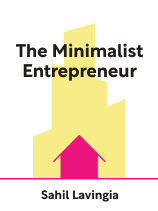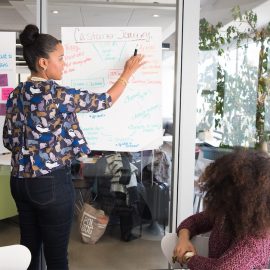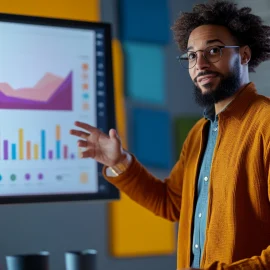

This article is an excerpt from the Shortform book guide to "The Minimalist Entrepreneur" by Sahil Lavingia. Shortform has the world's best summaries and analyses of books you should be reading.
Like this article? Sign up for a free trial here.
What is The Minimalist Entrepreneur about? What are the main takeaways of the book?
In The Minimalist Entrepreneur, Sahil Lavingia says you don’t need any funding to start a business. In his book, the successful business owner gives detailed advice for starting your own profitable “minimalist business without using venture capital.
Read below for a brief overview of The Minimalist Entrepreneur.
The Minimalist Entrepreneur by Sahil Lavingia
In The Minimalist Entrepreneur, business owner Sahil Lavingia gives detailed advice for starting your own modest but profitable business. Lavingia’s model emphasizes sustainable profit over the common “growth-at-all-costs” approach, and he says anyone can start a business using this method. You don’t need venture capital—in fact, you shouldn’t take any, he says. You only need to invest time until your business can give it back to you in abundance.
(Shortform note: Whether you rely on venture capital or not may depend on what kind of business you plan to start. Lavingia says the vast majority of businesses don’t need any, but it may be necessary for certain kinds of businesses that come with high start-up costs. There may be other benefits to using venture capital too—an important one is that you’d then have access to the investor’s network, which could help your business get exposure.)
Sahil Lavingia is the founder of a digital marketplace called Gumroad, a website that allows creators to sell digital content. He began Gumroad with the goal of turning it into a billion-dollar corporation. When that didn’t happen, he published an essay titled “Reflecting on My Failure to Build a Billion-Dollar Company” on his blog. That reflection would lead to his realization that he didn’t need a billion dollars. He realized if you allow your business to grow organically, keeping the costs at a minimum, it’ll eventually turn a profit that can give you a satisfying life. So he switched directions with Gumroad and turned it into the sustainably profitable business it is today. In The Minimalist Entrepreneur, Lavingia gives us step-by-step instructions on how to do the same.
We’ll take you through Lavingia’s advice for building a minimalist business from the ground up. We’ll start with how to identify the business you’ll want to create by looking in your own communities to discover needs you can fulfill. Then we’ll turn to the pragmatic details of setting up, testing, marketing, and launching your business. Next, we’ll discuss Lavingia’s advice for growing your business sustainably by managing your finances, creating a positive company culture, and hiring the right employees.
Finally, we’ll discuss the end goal—your contribution to the world and achievement of “time affluence,” an abundance of free time to enjoy your life.
Identify Your Business
The first step in building a minimalist business is identifying the right business for you. Lavingia stresses that it’s crucial to invest significant time and effort in this first step because this business will be your life and livelihood. Remember, you’re not looking to build a fast-growing company that you can turn around and sell to get rich quick. You’re building your life’s work. (Shortform note: Research has shown that despite often working longer hours and living with financial uncertainty, self-employed people are happier. They enjoy having autonomy and freedom to innovate, and they’re more engaged in their work.)
So before you dive into an exploration of what product or service you want to focus on, Lavingia advises you to keep a few things in mind:
- Don’t take venture capital. This makes you indebted to, and dependent on, the investors, and they’ll always want to emphasize fast growth. Venture capital is high-risk and high-return—and has a high rate of failure. Remind yourself that you don’t need a billion dollars. You just need a sustainable profit. (Shortform note: Whether you decide to seek venture capital or not may depend on what you prioritize. Do you prefer to keep firm control over your business, or would you rather give up some of that control for the guidance and connections a venture capital firm can provide you?)
- Don’t quit your day job and invest everything into this just yet. Start your business in your spare time as a side project. It will take time and you need income while you’re working on it. (Shortform note: One of the potential disadvantages to starting a business in your spare time is that you may continue to see it as a hobby rather than your career. Keeping the “safety net” of your day job could weaken the motivation and drive you might have if your business was your sole source of income.)
- Think of yourself as a creator, not a business person. You’re an innovative source of ideas, working on something you care about. This will help overcome some of the mental barriers of thinking you don’t know enough about “business.” The business is just the vehicle by which you’re making your creation available to the world. You don’t have to learn how to do everything first. You need to just start, and then learn as you go.
- Start small and slow. This will allow you to try out different approaches and change directions when you need to. You may have to try a few different things to find the right path, but you will eventually find it.
(Shortform note: In The $100 Startup, Chris Guillebeau says you can start a small business on your own with less than $100. His advice aligns closely with Lavingia’s, in that he advocates focusing on starting small, doing something you love, in your spare time. He says starting a small “microbusiness” gives you the ability to focus on something you care about, and set your own schedule. This will lead to both profit and life fulfillment.)
Open Your Business
Once you’ve nailed down your community and your problem, and you’ve established yourself as the creator of a solution, you’re ready to take the first steps to opening your business. We’ll discuss Lavingia’s advice for setting up your infrastructure and launching and marketing your business.
Set Up Your Infrastructure
Before launching your business, you’ll need to set up the infrastructure to run it. This will include a name, a website and email address, social media accounts, a payment system, and an avenue for feedback. Lavingia offers the following advice for each:
- Name your business. Lavingia says a key feature of your business name should be that it’s easy for people to remember and Google. Don’t make it too complicated to spell. He personally likes names that combine two easy words, like Facebook and Gumroad, but as long as it’s fairly simple and easy to remember, choose what you feel represents your product. (Shortform note: Before settling on your business name, you may want to do a trademark search to be sure the name isn’t already in use. You might also want to trademark your business name, so you have the exclusive legal rights to the name.).
- Create a website and business email address. Your website doesn’t need to be anything elaborate or pretty, as long as it’s functional, easy to navigate, and explains clearly what service or product you offer. (Shortform note: One of the mistakes businesses make is creating a website that’s too “busy.” In Building a Storybrand, Donald Miller says the only information people need from your website is: what you have to offer and how they can get it.)
- Create social media accounts for the business, separate from your personal ones. Depending on what your service or product is, some sites may work better than others. You might consider Facebook, Instagram, Twitter, Pinterest, YouTube, and TikTok.
- Set up a payment system through something like Square or Stripe.
- Have a feedback avenue. Lavingia says you’ll want to create a way to get fast and frequent feedback from customers, so you can constantly tweak accordingly.
Launch and Market
When you have your infrastructure set up, you’re ready to go. Lavingia says at this point you’ll launch and begin to market simultaneously.
He advises against paid advertising because it’s too expensive and too broadly targeted for a minimalist business. He says you don’t need to spend any money on marketing (Shortform note: Although much contemporary marketing advice suggests moving away from traditional paid advertisement, the US Small Business Administration says it can still be quite effective. They say in surveys, people indicate a much higher level of trust for TV, print, and radio ads, over online ones. So, if you do decide to pay for marketing, traditional advertisements may be the most effective route). You can do it all yourself because you’ve already established yourself with your target audience.
He also advises against having a launch party just yet. Instead, start by “cold calling” to educate people on your services, then begin more widespread social media marketing, then have your launch party.
Stay in Business
Once you’ve gotten off to a successful start and have a customer base, Lavingia says there are some important steps you can take to ensure your business stays successful and profitable and continues to grow organically. These are his minimalist methods for ensuring your business finds success:
- Focus on sustainability
- Create your company culture
- Improve your life and the world

———End of Preview———
Like what you just read? Read the rest of the world's best book summary and analysis of Sahil Lavingia's "The Minimalist Entrepreneur" at Shortform.
Here's what you'll find in our full The Minimalist Entrepreneur summary:
- Detailed advice for starting your own business without venture capital
- How to run your business sustainably and contribute to the world
- Why you don’t need to spend any money on marketing






